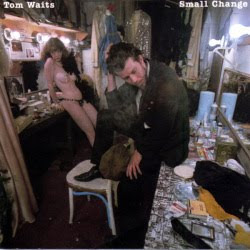(reissue)
Tom Waits
Asylum/ Rhino 7E-1078 180g LP
Produced by: Bones Howe
Engineered by: Bones Howe
Mixed by: Bones Howe
Mastered by: Gavin Lurssen
Lacquer Cut by: Ron McMaster at Capitol Mastering
MUSIC
SOUND
"Cut From the Analog Master Tapes"? Not Exactly
by Michael Fremer
February 01, 2011
Reissuing the Tom Waits Asylum catalog on vinyl was a good idea.
I've got most of the originals but since Rhino's current management can't even be bothered to send me email publicity blurbs, never mind promo copies to review, I choose to spend most of my money on new releases and my time reviewing records I buy and that some labels are kind enough to send me—and that doesn't guaranty a good review as I'm sure you know.
So I didn't order any of these reissues, but judging by Rhino's past track record, particularly when Warner Brothers vinyl maven Tom "Grover" Biery was involved, the results were uniformly excellent. But no good deed goes unpunished, and Mr. Biery involuntarily parted ways with Warner Brothers.
When the emails began to arrive complaining about these Tom Waits reissues, I had to hear what was going on.
"Sounds like wet socks," one reader wrote. "What's going on with the Tom Waits reissues, they sound dull and dead," wrote another.
I got emails from around the world complaining about this series.
Another reader was so upset he contacted Rhino to ask what could possibly have gone wrong.
What he found out was pretty shocking considering that the sticker on the plastic sealer read "Cut from the original analog tapes."
Not exactly.
The customer service person at Rhino told the reader that mastering engineer Gavin Lurssen had taken the 1/4" analog masters and using analog EQ, had equalized the tapes (essentially the same as mastering for all intents and purposes) and then created 96/24 bit files that were sent to Ron McMaster at Capitol where the lacquers were cut and then sent to RTI for plating and pressing.
No doubt the production was directed by someone at Rhino, not by Lurssen, who was doing his job as contracted by Rhino.
Something went terribly wrong somewhere in the chain because this Small Change does indeed sound thick, congealed, terribly rolled off and utterly airless. It's unfortunate that this review posts immediately following similar comments made about Mobile-Fidelity's equally dull and airless Dixie Chicken, but trust me: it's not my system. The original of Small Change sounds superb—and I used to play my copy often on the radio back in the '70s, so it's been played.
Yet despite its age and use it sounds bright, airy, open, three-dimensional and basically spectacular as one would expect from a Bones Howe production recorded live to two-track analog tape at Wally Heider's.
Yes, the trio of Shelly Manne, bassist Jim Hughart and saxophonist Lew Tabackin are playing live behind Waits and his piano as is the sumptuous sixteen piece string section. It's a spectacularly natural-sounding three dimensional recording of one of Waits' most colorful albums.
There's not a weak tune in the set and many classics like the greatest alcoholic in denial song "The Piano Has Been Drinking" and the Ron Popiel tribute "Step Right Up." Now "Step Right Up" is a simple quartet recording: the jazz trio and Waits. It should be spacious, open, three dimensional and just about every audio fan's idea of a sonic wet dream. At one point one of the players lets out a spontaneous yelp. It should knock you out of your seat. It's barely audible as are the finger snaps that should "pop" will realism.
What a shame.
What happened? First of all, why the hell wouldn't you just cut the fucking record from the master tape as long as you have it and you're in Hollywood—especially if you're advertising it as having been "cut from the original analog tapes?" Why digitize it? Why cut it at Capitol? Why Ron McMaster? He's known as a competent cutter in my opinion, but he's certainly not in the audiophile loop, nor am I sure Capitol's mastering room is up there with Kevin Gray's or Stan Ricker's, or Doug Sax's.
Who made such a choice? I can't imagine Gavin Lurssen equalized this record to have no top end. Something else must be going on here.
Who evaluated lacquer cuts before approving the project? I bet no one.
Who evaluated test pressings before approving the project? I bet no one.
And if it was someone, it was someone who doesn't know what he's doing.
This is a wonderful opportunity wasted.
Don't buy this and if you have bought it, you're entitled to your money back. You bought a record advertised as having been "cut from the analog master tape" and it wasn't.
Look, the Band on the Run reissue was cut from 96/24 bit files made from the master tapes and its arguably better than the U.S., British and German originals (review coming), so it's not the "digital" that ruined this. It's something else.
I'm trying to get answers.
Thanks to Michael over at www.musicangle.com for the exclusive rights to reprint this material. Stop by MusicAngle.com for more reviews and features.
©2011 MusicAngle.com & Michael Fremer - - All rights reserved
Reprinted by Permission









No comments:
Post a Comment